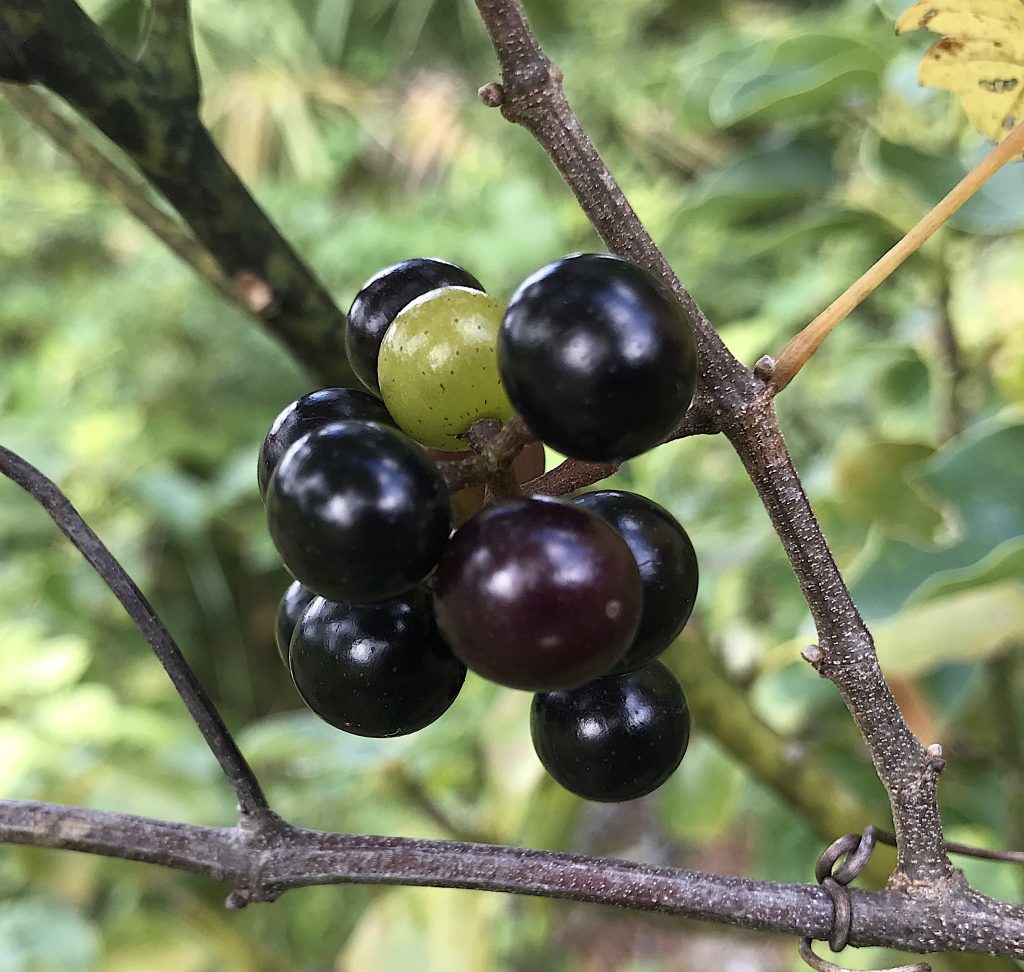
Wild Grapes are coming into season a little early this year. This single-tendril species tends to be high in acid. We saw these in Melbourne Fl. You can read about them here. Photo by Green Deane
With apologies this newsletter is starting with the foraging class schedule. Because of Word Press issues non-moving ads covered last week’s schedule resulting in one class with no attendances. That said only one class is scheduled this weekend and while there is an approaching storm we should have good weather for that class in Mead Garden (Winter Park) Saturday. (It was changed to Saturday because of the pending storm.) Perhaps no location has such a large concentration of wild edibles. The week after that I have a class at Ft. Desoto south of St. Pete presuming little damage from passing storm.
Saturday, August 1st, Mead Garden: 1500 S. Denning Dr., Winter Park, FL 32789. 9 a.m. to noon. The entrance is on the west side of Denning. Some GPS maps put it wrongly on the east side off Pennsylvania.
Sunday, August 9th, Ft. Desoto Park, 3500 Pinellas Bayway S. St. Petersburg Fl 33715. There is an entrance fee to the park. Meet at the fishing pier parking lot. 9 a.m to noon. (Same pier as the ferry.)
For more information, to pre-pay or sign up for a class go here.
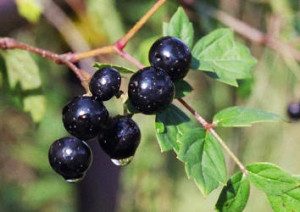
Peppervine got that name for a reason.
Putting on black fruit now is the controversial Pepper Vine, Ampelopsis arborea. It is closely related to the edible grape but also closely related to the toxic Virginia Creeper. It’s one of those plants that some folks say is definitely toxic and others say definitely edible. My personal experience is that it is not edible but I know some credible foragers who say they have eating the ripe berries for a long time with no issue. No doubt the problem has to do with annual calcium oxalate production. In small amounts it’s tolerable. In higher concentrations it can cause skin problems or internally upset digestion. Pepper Vine (so-called because the fruit can give a pepper-like burn) apparently can make little to a lot of the chemical each year, varying greatly. Another possibility is method of preparation. Some people juice the berries and let the juice sit in the refrigerator which allows the acid to precipitates. The juice is then carefully decanted through two coffee filters and used. Not for me but if you do said proceed with caution. The other caution is that Pepper Vine and Wild Grapes can grow intertwined and you can get some Pepper Vine fruit in with your grapes. This also can happen with Virginia Creeper. Pick your grapes carefully.
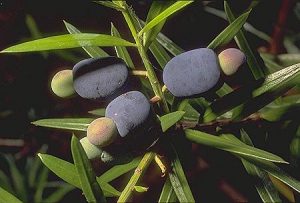
Podocarpus arils are edible. The seeds are not. Photo by Green Deane
This is a reminder that now is prime Podocarpus harvesting. Granted, most folks think of the Podocarpus (macrophyllus) as a hedge rather than a fruit but it has food nonetheless. The fleshy aril is edible and very grape-like. The seed, however we don’t eat. Break it off and toss it away. Like the Yaupon Holly, the Podocarpus is an extremely common hedge plant. It’s difficult to find a subdivision or public building that doesn’t have some shaping up the landscape. Where you must be careful is to not confuse the Yew for the Podocarpus (which can be a problem because the Podocarpus is often wrongly called “The Southern Yew.”) The non-edible seed of the Podocarpus is on the end of the stem, the aril closer to the main plant. With the Yew the seed is inside the aril, like a ball in a cup. Avoid the Yew until you know what you are doing. Its aril is edible but the seed deadly. Yew arils can be red or yellow. But again, the toxic Yew seed is inside the aril again like a ball in a cup. Do not eat the seed. Do not eat the seed of either species.
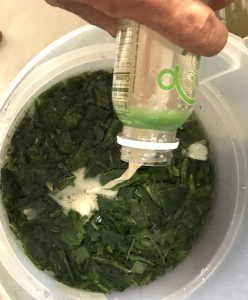
Adding Champagne yeast to three gallons of cactus pads and limes. Photo by Green Deane
Country Wine Update: A country wine is usually anything other than grapes made into wine. I have made wine for literally over 60 years (with some time off for bad behavior.) My first batch was Dandelion Wine way back in the early 60’s BC (Before Computers.) My latest pitch is Cactus Pad wine as we have a lot of them around. Usually such wine is made from the “Tuna” the purple fruit of the Cactus. This is reasonable in that they are sweet and can have a raspberry flavor (don’t forget to wash off the glochids and be careful of the seeds, they can break teeth.) You could make wine out of cactus blossoms only but it would be a delicate white wine and probably would be better off as a flavoring for mead. As I am using tender young Nopales pads and aiming for a dry or semi-dry wine I decided to add a good amount of lime to see what that combination might produce. Cactus pads are edible as long as they are pads and have no white sap. White sap means you have made a mistake and have a Euphorbia. They are toxic. Also fermenting in my one-room winery is St. John’s Mint Wine. I have decided to put that in seven-ounce bottles so I have a couple of dozen I can share with future classes. The biggest problem to making wine is finding bottles to put it in.
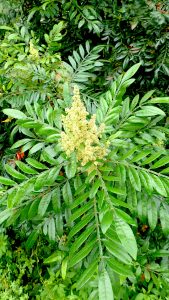
Sumacs are in blossom. Photo by Green Deane
What is that? It’s a common question locally now that Sumacs are in bloom. Their creamy terminal blossoms stand out looking somewhat exotic among the dark green foliage. The most common species here is Winged Sumac which is also one of the most widely-distributed sumac in North America. It’s found nearly everywhere though in different locales other species may dominate. Where I grew up in Maine Staghorn Sumac was the common species and grew quite tall. I see them often when I visit North Carolina. The key to making sure you have an edible sumac and not toxic Poison Sumac or Brazilian Pepper is the location of the blossom and subsequent fruit. Edible sumacs have terminal clusters of medium to dark red berries covered with fine hair. In this case “terminal” means they are on the very end of the branch, like the blossom on the right. Brazilian Pepper has pink berries that are further down the branch. Poison Sumac, which only grows only in wet places, has dull cream to green-cream berries also further down on the stem. To read more about Sumacs go here.
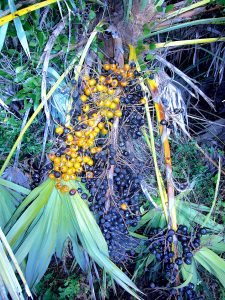
Soon most Saw Palmetto Berries will be turning gold then black.
As we are approaching August Saw Palmetto Berries are turning from green to gold. In another month they will be black and edible (so to speak.) Many folks find the flavor of Saw Palmetto berries revolting. I am not sure they are an “acquired” taste or a tolerated one. You will either be able to eat them or not. Basically they tastes like vomit. To be a little more gracious they taste like intense blue cheese with some burning hot pepper tossed in. Once you get used to them they are… endurable. But if you were hungry you would crave them in that they have all the amino acids humans need to be healthy. They are good for you even if you don’t like them. As with some fruit — Durian for example — the smell is enough to dissuade many people from eating them. Saw Palmetto berries will be ripening for the next month or so thus you have plenty of time to try one.

Green Deane videos are now available on a USB.
Changing foraging videos: My nine-DVD set of 135 videos has been selling for seven years and are still available. They are the same videos I have on You Tube. Some people like to have a separate copy. A second option is a16-gig USB that has those 135 videos plus 15 more. While the videos can be run from the DVDs the videos on the USB have to be copied to your computer to play. They are MP4 files. The150-video USB is $99 and the 135-video DVD set is now $99. The DVDs will be sold until they run out then will be exclusively replaced by the USB. This is a change I’ve been trying to make for several years. So if you have been wanting the 135-video DVD set order it now as the price is reduced and the supply limited. Or you can order the USB. My headache is getting my WordPress Order page changed to reflect these changes. We’ve been working on it for over three weeks. However, if you want to order now either the USB or the DVD set make a $99 “donation” using the link at the bottom of this page or here. That order form provides me with your address, the amount — $99 — tells me it is not a donation and in the note say if you want the DVD set or the USB.

Green Deane Forum
Want to identify a plant? Perhaps you’re looking for a foraging reference? You might have a UFO, an Unidentified Flowering Object, you want identified. On the Green Deane Forum we — including Green Deane and others from around the world — chat about foraging all year. And it’s not just about warm-weather plants or just North American flora. Many nations share common weeds so there’s a lot to talk. There’s also more than weeds. The reference section has information for foraging around the world. There are also articles on food preservation, and forgotten skills from making bows to fermenting food.
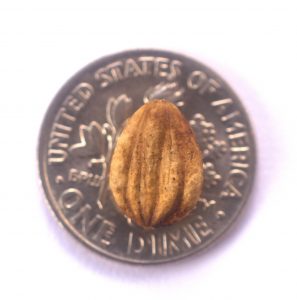
Black Gum seeds are easy to identify. Photo by Green Deane
Do you know why the Sweet Gum tree is called that? Because while it tastes mighty bad it is not as bad as the other “gum” trees, one of which is not season yet but is fruiting, the Black Gum.You have to like sour and bitter to like the Black Gum tree. If you don’t the fruit is offensive and elicits comments that cannot be printed in wholesome publications. This did not stop settlers from adding a lot of sugar to the fruit and making jelly out of it. The seed itself is easy to identify in that under the pulp there are vertical striations covering the seed. The tree usually looks gangly and has branches that are often on a 90-degree angle to the trunk. It likes to grow in wet spots and swams and the like. To read more about the Black Gum and its nearly-offensive but edible relatives click here.
This is weekly newsletter #416, If you want to subscribe to this free newsletter you can find the sign-up form in the menu at the top of the page.
To donate to the Green Deane Newsletter click here.


Thank you so much for sharing your wine making adventures. I too have been experimenting with Asian pears from my yard and other wild fruits. I’m excited to try cactus wine now! 😀